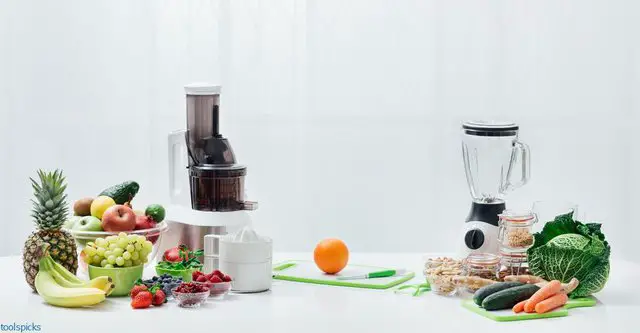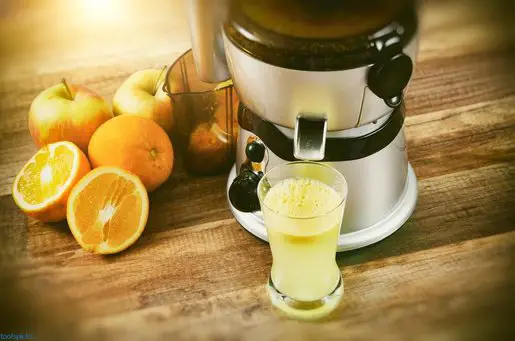The health world is overflowing with juice recipes and smoothie shops advertising these drinks as nutritious, tasty, and suitable delivery methods for everything we need. But all this attention to juicing can be confusing.
People question whether they can use a blender to juice their fruits and veggies or if they can use a juicer to make fresh creamy smoothies every morning. Truthfully, there are distinct differences between blenders and juicers, and it’s essential to know them. In this article, we help you figure out the blender vs juicer debate once and for all.
What’s a Juicer?
A juicer is a machine that extracts juice from fresh produce and then discards the remaining solids. The most effective machines remove all the fibrous pulp, leaving you with a concentrated, organic juice that’s convenient to drink and digest. There are masticating juicers, and centrifugal juicers to consider, but the end result is essentially the same.
How Does it Work?
Once you add your fruits or veggies, the juicer uses multiple methods to extract the juice from the solids. Depending on whether you have a masticating juicer or centrifugal juicer, it can spin, grate, crush or press the fruits and veggies to gather the liquid in a collection cup. The solids or pulp stay inside the appliance or in a separate section.
What’s a Blender?
A blender does more than extract liquids from food. It mixes and blends fruits, veggies, and other ingredients into one drink that leaves nothing for you to discard. Depending on whether you have a countertop blender or immersion blender, most can also tackle ice and other components, making it a more versatile device.
How Does it Work?
A countertop blender relies on speed and power. It has a motor that spins a series of blades to make a vortex inside. You can see the swirl if you have a transparent jar. The vortex pulls solid items down to chop them up and recirculate them. The longer it runs, the more uniform the blend becomes. Various speeds and blades also let you chop, grind, and even whip.
Blender vs Juicer – What’s the Difference?
Let’s decide on something beforehand. We can compare blenders and juicers, but one is not better than the other. They’re both great at what they do.
A juicer can satisfy your thirst but gives you extracted juice with barely any fiber or pulp. Its main benefit is that it’s easy to drink. The appliance provides concentrated nutrition since it removes the digestible liquid from your produce and focuses on simplicity. It lessens the need to eat large servings of fruits and veggies by making a single glass of healthy juice.
A blender can gratify your hunger by making thick nutrient-rich blended smoothies with fiber to help you feel full while satiating your appetite. It improves your nutrition by letting you use healthy ingredients such as yogurt or protein powder, so it focuses on flexibility. You’re adding and blending instead of extracting. So, you can make more recipes, sauces, kinds of butter, et cetera.
The answer to the blender vs juicer kitchen appliance debate comes down to what you want to do with your ingredients. Blenders focus on mixing and creating, so people can add more food ingredients to make thicker and richer recipes. Juicers extract juice, so you can use them to make healthy drinks that are easy to digest and drink.
Why Get a Juicer?
Juicers concentrate vitamins and minerals from produce. Most nutrients in fruit and veggies are in the juice rather than the pulp or fiber. So, juicers help increase the quantity and concentration of antioxidants like vitamin C so you can better absorb them. Also, they’re ideal for people with digestion issues who need healthy digestible juices for their wellbeing.
A juicer also provides fresh juice that’s healthier, tastier, and more nutritious than store-bought juices. The fresh juice retains essential nutrients due to pasteurization. In contrast, most store-bought ones use pasteurization to increase their shelf life.
People who prefer juices also mention other benefits:
- Extracted juices have anti-inflammatory properties that can help you improve your immune system.
- Juicers provide fresh juices that can flush toxins from your body.
- Fresh juice from fruits and veggies has enzymes to help digestion. That can help your gut work more effectively.
Why Get a Blender?
People end up buying many kitchen appliances thinking they need them but end up using them once or twice and then leaving them in their storage spaces to collect dust.
You won’t have this issue with blenders since they aren’t just for blending. Companies have made modern blenders multipurpose, unlike juicers, to work like food processors. Some can even heat mixtures, and most of these appliances manage to be multipurpose within their compact designs, so you can also store them easily.
Also, unlike juicers, blenders use every food component you throw. That is a significant benefit since the primary nutrient lost when juicers discard pulp is fiber.
Fruits and veggies retain their fiber even after blending so that you don’t have digestive issues or other gut diseases. Fiber is essential, especially since less than 5% of US citizens get their recommended daily fiber intake.
The pulp you lose from juicers and blenders reserve also offers plenty of flavonoids, a powerful type of phytonutrient. These potent nutrients can help fight against cancer and inflammation while effectively treating type II diabetes and other metabolic disorders.
Blended drinks are more filling than juices if you take care of your weight. Blenders allow you to add more food items to make healthier drinks and recipes, like healthy fats, avocados, seeds, nuts, et cetera. These items can delay the uptake of the sugars present in fresh fruit, so you stay full for longer without suffering from any sugar surges or crashes.
Also, while it may not be a huge selling point for some people, cleaning blenders is far easier than cleaning juicers. They don’t have multiple parts that you have to take apart, wash, dry, and then reassemble with each cleaning. To remove all food particles and stains, you only have to fill the blender with soapy water, put it on the lid, and use the appliance for 15 seconds.
Conclusion
That’s it for the blender vs juicer debate. These kitchen devices don’t have much in common, so it can be unfair to compare the two if you’re trying to decide which is better. They both help with health and nutrition, and it’s just that the methods and functionalities are different. Ultimately, it’s up to you to decide which one is ideal for your needs.



